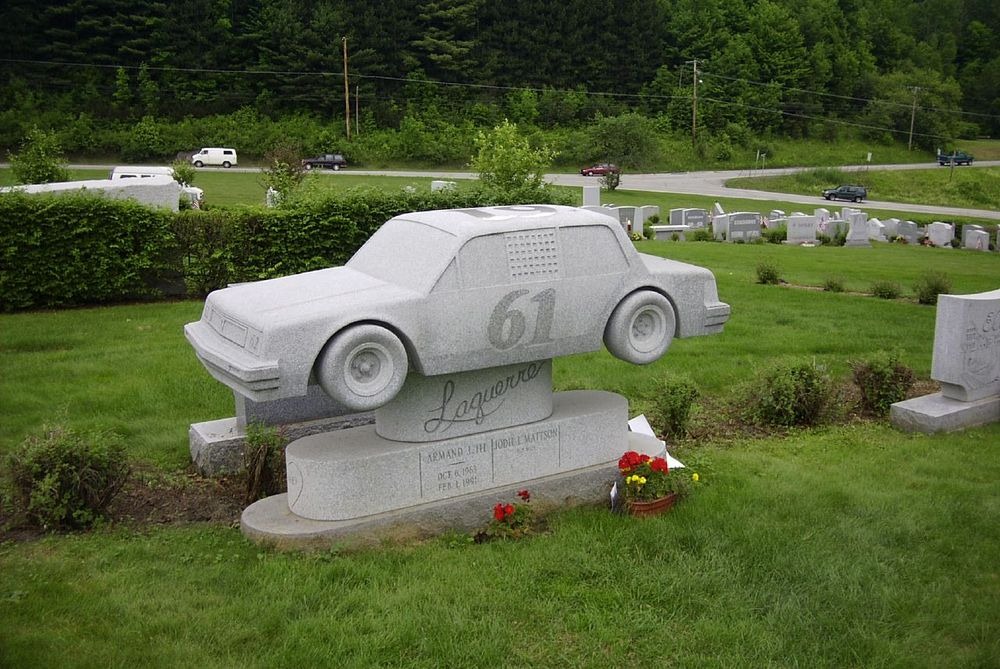One of the main uses of granite throughout America is in tombstones and memorials, and the finest examples of this craft can be seen at the Hope Cemetery, located in the tiny city of Barre, Vermont.
Known as the "Granite Capital of the World", Barre was established soon after the War of 1812 at the site of a vast granite deposit, which some geologists say is 4 miles long, 2 miles wide and 10 miles deep. When fame of this vast deposit spread to Europe and Canada, large number of businessmen as well as skilled artisans, especially from Italy, flocked to the city to become part of the booming granite industry. Soon "Barre Gray" granite became one of the most sought after worldwide because of its fine grain, even texture, and superior weather resistance. It is estimated that one-third of all memorials in the United States is crafted from Barre granite.

Photo credit: Melvin Mason/Flickr
The Hope Cemetery was established in 1895, and it immediately became the playground for the artisans of Barre. These skilled immigrants worked the hard stone and fashioned them into elaborate memorial designs.
But working with granite has fatal side effects. Inhaling the granite dust leads to a respiratory disease called silicosis, and many of the artisans and sculptors succumbed to it and died. When the Spanish flu epidemic swept through the area in 1918-19, many sculptors knowing that death was just round the corner, started designing their own tombstones to showcase their skill. The tradition has been carried on since then. It is estimated that 75% of the tombstones in Hope Cemetery were designed by the occupants of the graves themselves.
Originally 53 acres in size, the cemetery now covers 65 acres and holds over 10,000 artistic granite tombstones. Some of the fascinating examples include a half-size replica of race car to commemorate the death of local driver who died in a 1991 snowmobile mishap; a “marriage bed” with a couple in pajamas, sitting up and holding hands; a carved family portrait; a bas-relief of an 18-wheel truck; and tombs built in the shape of a soccer ball, a relief of an older man on a motorcycle, a baseball player etc.

Photo credit: 826 PARANORMAL/Flickr

Photo credit: Melvin Mason/Flickr

Photo credit: Melvin Mason/Flickr

Photo credit: Melvin Mason/Flickr

Photo credit: Melvin Mason/Flickr

Photo credit: Melvin Mason/Flickr

Photo credit: Melvin Mason/Flickr

Photo credit: 826 PARANORMAL/Flickr

Photo credit: 826 PARANORMAL/Flickr

Photo credit: Al/Flickr

Photo credit: 826 PARANORMAL/Flickr

Photo credit: Melvin Mason/Flickr

Photo credit: Melvin Mason/Flickr

Photo credit: Melvin Mason/Flickr
Sources: Wikipedia / Roadside America / Atlas Obscura
Known as the "Granite Capital of the World", Barre was established soon after the War of 1812 at the site of a vast granite deposit, which some geologists say is 4 miles long, 2 miles wide and 10 miles deep. When fame of this vast deposit spread to Europe and Canada, large number of businessmen as well as skilled artisans, especially from Italy, flocked to the city to become part of the booming granite industry. Soon "Barre Gray" granite became one of the most sought after worldwide because of its fine grain, even texture, and superior weather resistance. It is estimated that one-third of all memorials in the United States is crafted from Barre granite.

Photo credit: Melvin Mason/Flickr
The Hope Cemetery was established in 1895, and it immediately became the playground for the artisans of Barre. These skilled immigrants worked the hard stone and fashioned them into elaborate memorial designs.
But working with granite has fatal side effects. Inhaling the granite dust leads to a respiratory disease called silicosis, and many of the artisans and sculptors succumbed to it and died. When the Spanish flu epidemic swept through the area in 1918-19, many sculptors knowing that death was just round the corner, started designing their own tombstones to showcase their skill. The tradition has been carried on since then. It is estimated that 75% of the tombstones in Hope Cemetery were designed by the occupants of the graves themselves.
Originally 53 acres in size, the cemetery now covers 65 acres and holds over 10,000 artistic granite tombstones. Some of the fascinating examples include a half-size replica of race car to commemorate the death of local driver who died in a 1991 snowmobile mishap; a “marriage bed” with a couple in pajamas, sitting up and holding hands; a carved family portrait; a bas-relief of an 18-wheel truck; and tombs built in the shape of a soccer ball, a relief of an older man on a motorcycle, a baseball player etc.

Photo credit: 826 PARANORMAL/Flickr

Photo credit: Melvin Mason/Flickr

Photo credit: Melvin Mason/Flickr

Photo credit: Melvin Mason/Flickr

Photo credit: Melvin Mason/Flickr

Photo credit: Melvin Mason/Flickr

Photo credit: Melvin Mason/Flickr

Photo credit: 826 PARANORMAL/Flickr

Photo credit: 826 PARANORMAL/Flickr

Photo credit: Al/Flickr

Photo credit: 826 PARANORMAL/Flickr

Photo credit: Melvin Mason/Flickr

Photo credit: Melvin Mason/Flickr

Photo credit: Melvin Mason/Flickr
Sources: Wikipedia / Roadside America / Atlas Obscura
The Granite Sculptures of Hope Cemetery
4/
5
Oleh
Chandu Numerology






